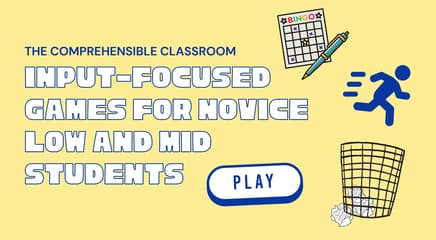Team Windows is another Kagan structure that works most wonderfully for small-group discussion about literature. In small groups, one member will make a statement, and the remainder express agreement or disagreement with that statement. One group member writes down the statement as well the number of group members that agree with it.

How to run Team Windows
- Students form groups of four students; three if necessary (three is always better than five!)
- Each group member is assigned a letter (A, B, C, or D)
- Student A makes a statement (see below for examples).
- Students B, C, D state whether they agree/disagree with that statement using complete sentences.
- Student A writes the statement in the box that corresponds with the total number of group members that agree with that statement (including him or herself). For example, if three members agree with it (Student A + 2 more), it should be written in the "Three Students" (Tres estudiantes) box.
- Roles rotate one person to the left, so that B makes the statement and records responses.
Uses for Team Windows in Language Classes
- Likes/dislikes (Ex: I like broccoli)...could also be used to practice synonyms/similar expressions for "like" (ex: gustar/encantar/interesar/fascina etc.)
- Need/want/have (Ex: I want chocolate OR (more complex) I have a dog BUT I want a cat)
- Comparisons (Ex: I think football is better than soccer.)
- Emotions (Ex: I feel happy when I play video games)
- Discussing literature: presenting opinions about characters, events, etc.), making predictions, etc. For my classes, I would most likely provide them with questions and only require that they discuss them. Some examples of questions for them to discuss appear in my Fan'N'Pick post. This great suggestion came from B-Lo!
- One REALLY wonderful idea came from a teacher that I don't know :( Maybe another class member could provide her name? She suggested that each student in the group role-play as though they were a character from the story. They would then be given a list of opinions about events or people from the story (ex: Cinderella is so lazy!) and required to express agreement/disagreement based on how their character would respond. For example, Cinderella's step-sisters would agree that she is lazy, but Prince Charming would disagree. You could also give a random list of statements and allow students to get creative. Would Prince Charming support school uniforms? Students would have to use their knowledge of the character to defend their response.
Follow-up activities for Team Windows
Consider doing a follow-up writing activity in which students write about their group's findings or elaborate on their own opinions that were shared during the activity. One of my favorite follow-ups is to have each group take the statements from their most-common categories (3+ group members) and put them on a poster. Then, each group can compare their discussion to the discussion had in other groups using Gallery Walk!
Get a Team Windows worksheet
This document has a Spanish page, a French page (translated by Wendy Organ), an English page, and a Blank page.





